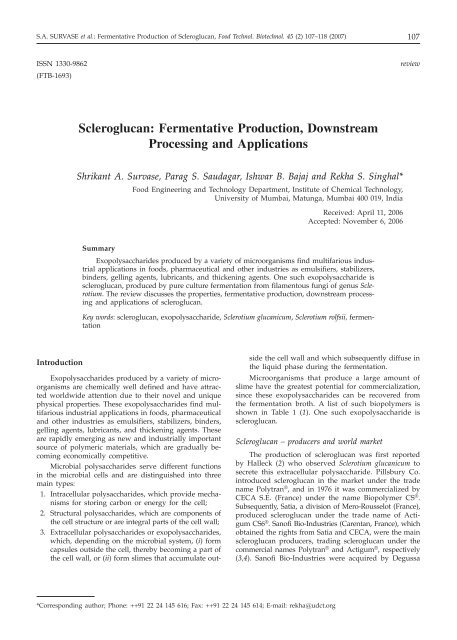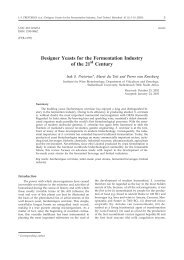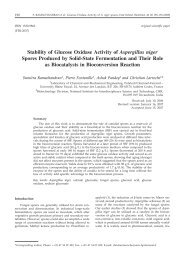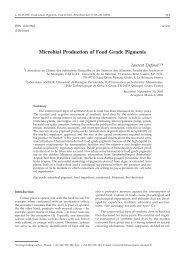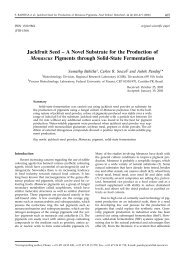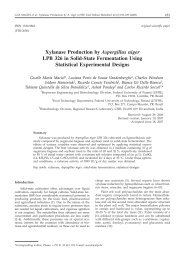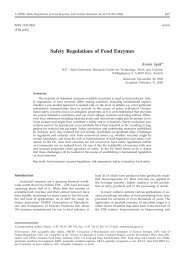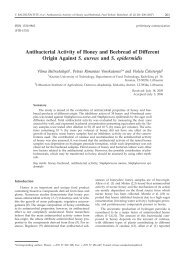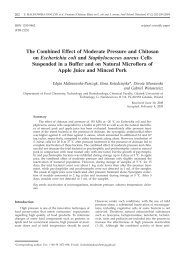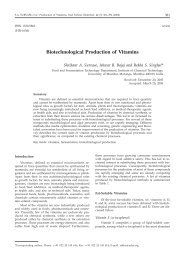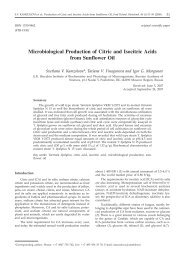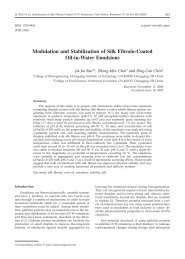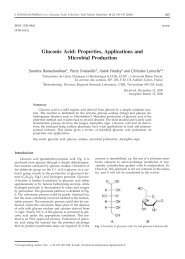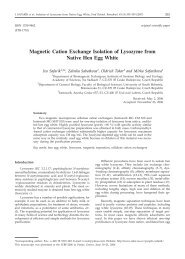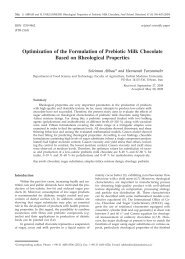Scleroglucan - Food Technology and Biotechnology
Scleroglucan - Food Technology and Biotechnology
Scleroglucan - Food Technology and Biotechnology
You also want an ePaper? Increase the reach of your titles
YUMPU automatically turns print PDFs into web optimized ePapers that Google loves.
S.A. SURVASE et al.: Fermentative Production of <strong>Scleroglucan</strong>, <strong>Food</strong> Technol. Biotechnol. 45 (2) 107–118 (2007)<br />
107<br />
ISSN 1330-9862<br />
(FTB-1693)<br />
review<br />
<strong>Scleroglucan</strong>: Fermentative Production, Downstream<br />
Processing <strong>and</strong> Applications<br />
Shrikant A. Survase, Parag S. Saudagar, Ishwar B. Bajaj <strong>and</strong> Rekha S. Singhal*<br />
<strong>Food</strong> Engineering <strong>and</strong> <strong>Technology</strong> Department, Institute of Chemical <strong>Technology</strong>,<br />
University of Mumbai, Matunga, Mumbai 400 019, India<br />
Received: April 11, 2006<br />
Accepted: November 6, 2006<br />
Summary<br />
Exopolysaccharides produced by a variety of microorganisms find multifarious industrial<br />
applications in foods, pharmaceutical <strong>and</strong> other industries as emulsifiers, stabilizers,<br />
binders, gelling agents, lubricants, <strong>and</strong> thickening agents. One such exopolysaccharide is<br />
scleroglucan, produced by pure culture fermentation from filamentous fungi of genus Sclerotium.<br />
The review discusses the properties, fermentative production, downstream processing<br />
<strong>and</strong> applications of scleroglucan.<br />
Key words: scleroglucan, exopolysaccharide, Sclerotium glucanicum, Sclerotium rolfsii, fermentation<br />
Introduction<br />
Exopolysaccharides produced by a variety of microorganisms<br />
are chemically well defined <strong>and</strong> have attracted<br />
worldwide attention due to their novel <strong>and</strong> unique<br />
physical properties. These exopolysaccharides find multifarious<br />
industrial applications in foods, pharmaceutical<br />
<strong>and</strong> other industries as emulsifiers, stabilizers, binders,<br />
gelling agents, lubricants, <strong>and</strong> thickening agents. These<br />
are rapidly emerging as new <strong>and</strong> industrially important<br />
source of polymeric materials, which are gradually becoming<br />
economically competitive.<br />
Microbial polysaccharides serve different functions<br />
in the microbial cells <strong>and</strong> are distinguished into three<br />
main types:<br />
1. Intracellular polysaccharides, which provide mechanisms<br />
for storing carbon or energy for the cell;<br />
2. Structural polysaccharides, which are components of<br />
the cell structure or are integral parts of the cell wall;<br />
3. Extracellular polysaccharides or exopolysaccharides,<br />
which, depending on the microbial system, (i) form<br />
capsules outside the cell, thereby becoming a part of<br />
the cell wall, or (ii) form slimes that accumulate outside<br />
the cell wall <strong>and</strong> which subsequently diffuse in<br />
the liquid phase during the fermentation.<br />
Microorganisms that produce a large amount of<br />
slime have the greatest potential for commercialization,<br />
since these exopolysaccharides can be recovered from<br />
the fermentation broth. A list of such biopolymers is<br />
shown in Table 1 (1). One such exopolysaccharide is<br />
scleroglucan.<br />
<strong>Scleroglucan</strong> – producers <strong>and</strong> world market<br />
The production of scleroglucan was first reported<br />
by Halleck (2) who observed Sclerotium glucanicum to<br />
secrete this extracellular polysaccharide. Pillsbury Co.<br />
introduced scleroglucan in the market under the trade<br />
name Polytran ® , <strong>and</strong> in 1976 it was commercialized by<br />
CECA S.E. (France) under the name Biopolymer CS ® .<br />
Subsequently, Satia, a division of Mero-Rousselot (France),<br />
produced scleroglucan under the trade name of Actigum<br />
CS6 ® . Sanofi Bio-Industries (Carentan, France), which<br />
obtained the rights from Satia <strong>and</strong> CECA, were the main<br />
scleroglucan producers, trading scleroglucan under the<br />
commercial names Polytran ® <strong>and</strong> Actigum ® , respectively<br />
(3,4). Sanofi Bio-Industries were acquired by Degussa<br />
*Corresponding author; Phone: ++91 22 24 145 616; Fax: ++91 22 24 145 614; E-mail: rekha@udct.org
108 S.A. SURVASE et al.: Fermentative Production of <strong>Scleroglucan</strong>, <strong>Food</strong> Technol. Biotechnol. 45 (2) 107–118 (2007)<br />
Table 1. Various exopolysaccharides of industrial importance<br />
Product Substrate Microorganism Yield*/%<br />
Alginate Sucrose Azotobacter vinel<strong>and</strong>ii NCIB 9068 5<br />
Curdlan type Glucose 5 % Alcaligenes faecalis var. myxogenes 10C3 IFO 13140 50<br />
Levan Sucrose 2 % Zymomonas mobilis NCIB 8938
S.A. SURVASE et al.: Fermentative Production of <strong>Scleroglucan</strong>, <strong>Food</strong> Technol. Biotechnol. 45 (2) 107–118 (2007)<br />
109<br />
<strong>and</strong> stable molecular mass under different fermentation<br />
conditions. When dissolved in water, scleroglucan forms<br />
linear triple helices (9), where the side glucose groups<br />
protrude <strong>and</strong> prevent helices from aggregating. This stabilizes<br />
the polysaccharide, but reduces its gelling ability.<br />
The triple helix structure is quite thermostable, but dissolves<br />
into single r<strong>and</strong>om coils when dispersed in dimethyl<br />
sulphoxide (DMSO) or at pH over 12.5. <strong>Scleroglucan</strong><br />
has a structure that is identical to schizophyllan, which<br />
is produced by Schizophyllum commune. Schizophyllan has<br />
slightly higher molecular mass than scleroglucan (10).<br />
Properties of <strong>Scleroglucan</strong><br />
The properties of scleroglucan may be influenced by<br />
the molecular mass <strong>and</strong> by recovery methods. In addition,<br />
the solution properties of scleroglucan may also be<br />
different, depending on the grade used. Biopolymer CS-6<br />
contains 60–70 % of scleroglucan, whereas biopolymer<br />
CS-11 is a refined product containing 85–90 % polysaccharide.<br />
Dissolution<br />
<strong>Scleroglucan</strong> disperses rather easily in water at room<br />
temperature due to the presence of b-D-(1–6)-glucopyranosyl<br />
groups that increase the solubility of the polysaccharide<br />
<strong>and</strong> decrease the ability to form the gels (3,11).<br />
Refined grades of scleroglucan dissolve readily in hot <strong>and</strong><br />
cold water to form pseudoplastic solutions with shear<br />
thinning characteristics that tolerate high temperature,<br />
broad range of pH, <strong>and</strong> a variety of electrolytes, whereas<br />
the crude isolate from the fermentation broth produces<br />
low viscosity solutions. Mixing, temperature, pH, <strong>and</strong><br />
concentration influence the rate at which viscosity develops.<br />
The viscosity of scleroglucan solutions is affected<br />
only slightly by temperature variations. At 0.5<br />
<strong>and</strong> 2.0 %, it remains practically constant between 10<br />
<strong>and</strong> 90 °C. At low temperatures, close to 7 °C, solutions<br />
of scleroglucan form thermoreversible gels that may be<br />
caused by weakly interacting triple helix cross linking<br />
mechanism (10). The viscosity of scleroglucan is unaffected<br />
over a pH range of 1 to 11. In dimethyl sulphoxide,<br />
in aqueous solutions of pH=12.5 or higher, or at<br />
temperatures above 90 °C, the reduced viscosity, specific<br />
rotation, <strong>and</strong> sedimentation coefficient indicate disruption<br />
of the triple helical structure to a single r<strong>and</strong>om coil<br />
(12). Among 140 polymers tested for use in polymer<br />
flooding in the North Sea oil reservoirs, scleroglucan<br />
was the most stable, retaining more than 90 % of its viscosity<br />
after 500 days at 90 °C in seawater (5).<br />
<strong>Scleroglucan</strong> forms stable gels in the presence of<br />
chromium salts <strong>and</strong> borax at pH=10–11, <strong>and</strong> can be precipitated<br />
by the addition of quaternary ammonium salts<br />
under alkaline conditions.<br />
Compatibility<br />
Prehydrated scleroglucan is compatible with electrolytes<br />
such as 5 % sodium chloride, 5 % sodium sulphate,<br />
20 % calcium chloride, <strong>and</strong> 10 % disodium hydrogen<br />
phosphate (11). However, when the electrolyte concentrations<br />
are very high, solutions may gel <strong>and</strong> flocculate.<br />
<strong>Scleroglucan</strong> is compatible, without synergism, with most<br />
other thickeners such as locust bean gum, alginates, xanthan,<br />
<strong>and</strong> carrageenan <strong>and</strong> cellulose derivatives. While<br />
scleroglucan remains soluble in the mixtures containing<br />
50 % of glycols or polyols, solutions have high viscosity<br />
only when the polyol concentration is above 20 % (5).<br />
Rheology<br />
Pseudoplasticity, or shear thinning, is the salient characteristic<br />
of scleroglucan solutions. Pseudoplasticity is<br />
evident in the gum solutions of 0.2 % or lower, but the<br />
flow becomes progressively more Newtonian as the concentration<br />
decreases below 0.2 %. Solutions containing<br />
less than 0.8 % of scleroglucan are not significantly thixotropic,<br />
except at temperatures dropping to 10 °C <strong>and</strong><br />
below. Above 20 °C, as determined by the Brookfield-<br />
-type viscometer, the hysteresis loops traced by the response<br />
of shear stress to increasing <strong>and</strong> decreasing shear<br />
rate are of negligible proportions (7).<br />
Due to high degree of pseudoplasticity, gel states are<br />
not always clearly defined. Thus, 1.2–1.5 % solutions of<br />
purified gum form self-supporting sliceable gels at approximately<br />
25 °C, but at temperatures below 10 °C,<br />
even very diluted solutions form diffusely structured<br />
gels that tend to shrink <strong>and</strong> undergo syneresis when left<br />
undisturbed for long periods of time. Such diffused gels<br />
disperse quickly with mild agitation.<br />
Suspending properties<br />
A pseudoplastic flow system inherently combines a<br />
capacity for suspending fine particles with good pourability<br />
of suspension. Purified scleroglucan at 0.1–0.2 % effectively<br />
stabilizes 5–10 % aqueous suspensions of fine<br />
powders such as zinc oxide, reprecipitated calcium carbonate,<br />
<strong>and</strong> sulphamerazine. The viscosity of combinations<br />
of scleroglucan with bentonite suspensions is markedly<br />
synergistic. Thus, while the apparent viscosities of<br />
0.15 % purified gum <strong>and</strong> 5 % bentonite are around 200<br />
<strong>and</strong> 300 cps, respectively, a combination of the two yields<br />
the viscosity of >4000 cps. Although not a primary emulsifier<br />
in the sense of a surfactant, scleroglucan enables<br />
very low energy dispersion during the formation of stable<br />
oil-in-water emulsions. In addition to the suspending<br />
action of the pseudoplastic system, prevention of coalescence<br />
seems to underlie this kind of stabilization (3,5).<br />
Physiology<br />
Short <strong>and</strong> long term feeding studies with rats <strong>and</strong><br />
dogs have not shown any toxicity, blood abnormalities,<br />
or significant tissue pathology. Eye <strong>and</strong> skin tests involving<br />
guinea pigs, rabbits <strong>and</strong> humans have not demonstrated<br />
significant adverse reactions or sensitization. With<br />
chicks <strong>and</strong> dogs, scleroglucan in the diet lowered the<br />
cholesterol levels <strong>and</strong> increased the excretion of lipids<br />
(13). Like other b-glucans, scleroglucan displays antitumor<br />
activity, but it is more effective than other polysaccharides<br />
such as curdlan <strong>and</strong> b-glucan.<br />
Microbial Strains Producing <strong>Scleroglucan</strong><br />
<strong>Scleroglucan</strong> is synthesized extracellularly by species<br />
of the genus Sclerotium, i.e. Sclerotium glucanicum, Sclerotium<br />
rolfsii <strong>and</strong> Sclerotium delphinii. Corticium rolfsii <strong>and</strong>
110 S.A. SURVASE et al.: Fermentative Production of <strong>Scleroglucan</strong>, <strong>Food</strong> Technol. Biotechnol. 45 (2) 107–118 (2007)<br />
Schizophyllum commune produce other polysaccharides that<br />
are structurally very similar to scleroglucan (2,14). The<br />
two main species for its production are Sclerotium glucanicum<br />
(15–18) <strong>and</strong> Sclerotium rolfsii (6,19–23).<br />
Sclerotium glucanicum <strong>and</strong> Sclerotium rolfsii are heterotrophic<br />
filamentous fungi, which are characterized as<br />
plant pathogens <strong>and</strong> parasites. They possess enzymes including<br />
cellulases, phosphatidase, arabinase, exogalactanase,<br />
polygalacturanase, galactosidase <strong>and</strong> exomannase.<br />
These organisms also produce oxalic acid, which facilitates<br />
plant cell lysis. Sclerotium species have brown or<br />
black sclerotia (aggregated bodies of hyphae) or light-<br />
-coloured mycelia, <strong>and</strong> do not sporulate (24). Sclerotia<br />
are more resistant to biological or chemical degradation<br />
than mycelia. In liquid media the organism forms pellets<br />
with central capsules from which hyphal residues extend.<br />
On solid media, aerial hyphae are formed <strong>and</strong> organized<br />
in mycelia. The role of scleroglucan in the life of<br />
the organism is mainly to assist in attachment to plant<br />
surfaces <strong>and</strong> the protection of sclerotia against unfavourable<br />
environmental conditions such as desiccation (25).<br />
In addition, scleroglucan may have a role as energy<br />
source. The hydrolytic enzymes synthesized by Sclerotium<br />
species degrade scleroglucan into glucose molecules,<br />
indicating that the microorganisms may utilize the<br />
biopolymer when other carbon sources are depleted<br />
(26).<br />
Farina et al. (27) measured the colony radial growth<br />
rate (Kr) on solid medium of colonies of Sclerotium rolfsii<br />
Proimi F-6656 for the evaluation of scleroglucan production<br />
medium <strong>and</strong> other different media, incubation temperature<br />
<strong>and</strong> tolerance to diverse concentrations of sucrose<br />
<strong>and</strong> NaCl. The optimum growth temperature observed<br />
was 30 °C. The fungus tolerated concentrations<br />
of sucrose from 0.15 to 1.17 M on both Czapek <strong>and</strong> production<br />
medium. Growth was limited by the highest<br />
concentrations of sucrose tested (0.88 <strong>and</strong> 1.17 M), as indicated<br />
by a slower increase in colony size. Addition of<br />
0.86 M NaCl to the production medium <strong>and</strong> yeast extract-malt<br />
extract agar (YMA) did not inhibit the growth<br />
completely, but decreased the radial growth rate considerably<br />
(80 <strong>and</strong> 70 %, respectively).<br />
Biosynthetic Pathway<br />
Sutherl<strong>and</strong> (28,29) suggested a general pathway for<br />
the biosynthesis of extracellular polysaccharides in three<br />
major steps: (i) substrate uptake, (ii) intracellular formation<br />
of polysaccharide, <strong>and</strong> (iii) extrusion from the cell.<br />
There is very little information available on the biosynthesis<br />
for scleroglucan formation in Sclerotium glucanicum<br />
<strong>and</strong> Sclerotium rolfsii, but generally this should<br />
resemble the biosynthetic steps encountered in the production<br />
of other glucans. First, glucose is transferred<br />
into the cells via a hexokinase <strong>and</strong> is then phosphorylated<br />
by the action of phosphoglucomutase (PGM) <strong>and</strong><br />
phosphoglucoisomerase (PGI). Pyrophosphorylase (UGP)<br />
catalyses the formation of uridine diphosphate glucose<br />
(UDP-glucose), which reacts with lipid carrier <strong>and</strong> initiates<br />
polymerisation. This proposed pathway for the production<br />
of scleroglucan is depicted schematically in Fig.<br />
2(7).<br />
Fermentative Production of <strong>Scleroglucan</strong><br />
In general, factors affecting scleroglucan production<br />
include inoculum preparation, growth medium, environmental<br />
conditions, <strong>and</strong> the formation of byproducts.<br />
Increasing the rate <strong>and</strong> extent of polysaccharide synthesis,<br />
eliminating undesirable enzyme activities or trans-<br />
<br />
<br />
<br />
<br />
<br />
<br />
<br />
<br />
<br />
<br />
<br />
<br />
<br />
<br />
<br />
<br />
<br />
<br />
Fig. 2. Biosynthetic pathway for scleroglucan synthesis
S.A. SURVASE et al.: Fermentative Production of <strong>Scleroglucan</strong>, <strong>Food</strong> Technol. Biotechnol. 45 (2) 107–118 (2007)<br />
111<br />
ferring the genetic determinants of polysaccharide synthesis<br />
to more amenable host organisms can improve<br />
the polysaccharide production.<br />
Effect of composition of culture medium<br />
The amount of carbon substrate converted by the cell<br />
to polymer depends upon the composition of growth medium<br />
<strong>and</strong> under certain conditions the product may not<br />
be produced at all. Generally, media containing high<br />
carbon to limiting nutrient ratio (often nitrogen) is favoured<br />
for polysaccharide production. Conversion of<br />
60–80 % of the utilized carbon source into crude polymer<br />
is commonly found in high yielding polysaccharide<br />
fermentations. Care must be taken in the interpretation<br />
of such yields because crude products often contain<br />
cells, other organic materials <strong>and</strong> salts which are co-precipitated<br />
with the polymer when it is recovered from<br />
fermentation broth (1).<br />
The optimal design of the medium is very important<br />
in the growth of microorganisms, stimulating the<br />
formation of products <strong>and</strong> providing the necessary energy<br />
for metabolic purposes. The nutrients required by a<br />
fungus include macronutrients such as carbon, oxygen,<br />
nitrogen, phosphorus, sulphur, potassium <strong>and</strong> magnesium,<br />
which comprise an average 98 % of dry cell mass<br />
of fungi.<br />
Carbon source<br />
Usually, glucose <strong>and</strong> sucrose are used as carbon<br />
sources for biopolymer production, although other carbohydrates<br />
can also be utilized. Most studies on scleroglucan<br />
report a glucose or sucrose concentration of either<br />
30 g/L (18) or35g/L(21). Under these conditions,<br />
a maximum yield of 8.5–10 g/L was obtained for scleroglucan,<br />
which is much lower than the highest reported<br />
concentration of 27 g/L of xanthan, the main rival of<br />
scleroglucan. Sucrose concentrations above 45 g/L have<br />
been found to inhibit growth of Sclerotium glucanicum,<br />
<strong>and</strong> further limit the scleroglucan production (30). In<br />
contrast to this, Farina et al. (19) studied the effect of<br />
high sucrose concentrations on the scleroglucan production<br />
by S. rolfsii <strong>and</strong> concluded that an increase in sucrose<br />
led to a clear improvement in glucan yield. While<br />
only 7 g/L of scleroglucan were produced with 30 g/L<br />
of initial sucrose, a threefold increase (21 g/L) of product<br />
occurred when 150 g/L sucrose were supplied to the<br />
culture medium. Despite this improvement, residual sucrose<br />
at the end of fermentation was as high as 100 g/L,<br />
thus questioning the economic benefits of this strategy.<br />
Survase et al. (22) reported the maximum production of<br />
16.5 g/L at a sucrose concentration of 80 g/L.<br />
Nitrogen source<br />
Nitrogen comprises 8–14 % of the dry cell mass of<br />
bacteria <strong>and</strong> fungi. It is a component of proteins <strong>and</strong> enzymes,<br />
<strong>and</strong> it is necessary in cell metabolism. A wide<br />
range of inorganic <strong>and</strong> organic compounds such as inorganic<br />
salts of NH 4+ <strong>and</strong> NO 3– , or more complex, natural<br />
products such as yeast extract, casein hydrolyzate, soya<br />
hydrolyzate <strong>and</strong> corn steep liquor can be utilized to satisfy<br />
the requirement of this element (31). Generally, the<br />
addition of extra nitrogen favours the biomass concentration,<br />
but diminishes glucan formation. In the case of<br />
a glucan such as pullulan, the production of polysaccharide<br />
is stimulated by depletion of nitrogen source. Similarly,<br />
high concentrations of nitrogen in the form of<br />
ammonium sulphate have been reported to reduce the<br />
scleroglucan production (19). Also, nitrate rather than<br />
ammonium sulphate give better glucan levels (19,22).<br />
Ammonium was reported to inhibit the glucan-synthesizing<br />
enzymes.<br />
Miscellaneous<br />
Phosphorus is an important element for secondary<br />
metabolism, <strong>and</strong> it also regulates lipid <strong>and</strong> carbohydrate<br />
uptake by the cells. Phosphate salts, such as K 2 HPO 4 or<br />
KH 2 PO 4 , also serve as a pH buffer in the fermentation<br />
medium (32,33). Farina et al. (19) indicatedanincrease<br />
of total phosphorus from 0.12 to 0.28 g/L to improve<br />
scleroglucan production (from 4 to 5 g/L). Although a<br />
clear explanation for this was not given, it is possible<br />
that phosphorus might increase glucose uptake <strong>and</strong> metabolism.<br />
Potassium is the principal inorganic cation in the<br />
cell; it is usually added as an inorganic salt (e.g. K 2 SO 4 ,<br />
K 2 HPO 4, or KH 2 PO 4 ). Potassium is a cofactor for some<br />
enzymes, required in the carbohydrate metabolism <strong>and</strong><br />
in many transport processes. Magnesium is also required<br />
by fungi, it functions as an enzyme cofactor, <strong>and</strong> is present<br />
in cell walls <strong>and</strong> membranes. It is usually supplied<br />
as MgSO 4·7H 2 O.<br />
Pilz et al. (34) noticed that thiamine <strong>and</strong> zinc addition<br />
in a defined mineral medium could replace yeast<br />
extract. Their results indicate the importance of meeting<br />
the zinc requirement of the microorganisms. S. rolfsii<br />
needs Zn 2+ for its primary metabolism <strong>and</strong> for the production<br />
of scleroglucan in a mineral medium.<br />
Effect of precursors<br />
Addition of precursor molecules is of considerable<br />
importance in the polysaccharide synthesis in terms of<br />
metabolic driving force. In case of polysaccharides, higher<br />
intracellular levels of nucleotide phosphate sugars under<br />
nitrogen-limited conditions enhance metabolite flux<br />
of exopolysaccharide synthesis. Higher intracellular levels<br />
of UMP under nitrogen-limited conditions enhance<br />
metabolite flux of curdlan synthesis in Agrobacterium species<br />
(35). Gellan precursors were detected by enzyme assays,<br />
<strong>and</strong> they were found to be nucleotide phosphate<br />
sugars (36). Amino acids have been used by some researchers<br />
as nitrogen source or as stimulator for improving<br />
biopolymer yields such as gellan gum production (37).<br />
Although there is inadequate information available on<br />
the use of amino acids as precursors for scleroglucan production,<br />
L-threonine was used in the optimized medium,<br />
but it did not show an increased yield (19). Survase et al.<br />
(23) used sugar nucleotides <strong>and</strong> amino acids <strong>and</strong> concluded<br />
that sugar nucleotides such as UMP, UDPG <strong>and</strong><br />
amino acid such as L-lysine could serve as metabolic precursors<br />
for the scleroglucan production. Addition of precursors<br />
significantly improved the yield, but not the molecular<br />
mass of scleroglucan.
112 S.A. SURVASE et al.: Fermentative Production of <strong>Scleroglucan</strong>, <strong>Food</strong> Technol. Biotechnol. 45 (2) 107–118 (2007)<br />
Effect of environmental factors<br />
Microorganisms respond rapidly to environmental<br />
changes in many different ways, such as induction <strong>and</strong><br />
repression of protein synthesis, change in cell morphology,<br />
<strong>and</strong> enzyme inhibition or stimulation. In a bioreactor,<br />
the main environmental parameters of interest are<br />
pH, temperature, dissolved oxygen, <strong>and</strong> stirrer speed.<br />
The physiology of Sclerotium glucanicum has been<br />
studied by many people in order to underst<strong>and</strong> how the<br />
microorganism functions <strong>and</strong> responds to the controlled<br />
environment, <strong>and</strong> to optimize process conditions for<br />
scleroglucan production.<br />
Temperature<br />
The internal temperature of the microorganism must<br />
be equal to that of its environment. Like many chemical<br />
reactions, the microbial activity is sensitive to environmental<br />
temperature. Temperature is crucial parameter<br />
that affects both culture growth <strong>and</strong> polysaccharide production.<br />
However, optimal temperature for exopolysaccharide<br />
production (20–37 °C) (2) isdifferentfromthat<br />
for culture growth (28 o C) (15). Below 28 °C, oxalic acid<br />
formation is enhanced, which has an adverse effect on<br />
scleroglucan production.<br />
pH<br />
pH influences the physiology of a microorganism<br />
significantly by affecting nutrient solubility <strong>and</strong> uptake,<br />
enzyme activity, cell membrane morphology, byproduct<br />
formation <strong>and</strong> oxidative reductive reactions. Culture pH<br />
can have profound effects on both the rate of production<br />
<strong>and</strong> the synthesis of polysaccharides. As with temperature,<br />
the appropriate pH for maximum production of the<br />
polysaccharide can differ from that for optimum growth.<br />
In case of xanthan production, Moraine <strong>and</strong> Rogovin (38)<br />
observed that culture pH influenced polysachharide production<br />
more than cell growth. Kang <strong>and</strong> Cottrell (39)<br />
reported fungal biopolymer synthesis to be optimal in<br />
the range of pH=4.0–5.5. Based on these observations,<br />
researchers have developed two-stage processes, with<br />
the first stage designed for optimal culture growth <strong>and</strong><br />
the second stage for maximum polysaccharide production.<br />
Lacroix et al. (40) conducted fermentations for pullulan,<br />
another fungal glucan, wherein at the first stage,<br />
the pH of 2.0 was maintained for the best biomass <strong>and</strong><br />
growth rate. Once high levels of biomass were achieved,<br />
the pH was adjusted to 5.5 for maximum pullulan production.<br />
In a similar mode, Wang <strong>and</strong> McNeil (16) reported<br />
an improved scleroglucan production via atwo-<br />
-stage process. In the first phase, pH was controlled at<br />
3.5 for optimal growth, after which pH=4.5 was used to<br />
promote polysaccharide synthesis. The increased production<br />
of scleroglucan achieved under these conditions<br />
was combined with a 10 % reduction of byproduct formation.<br />
This probably indicates that at pH levels higher<br />
than those for optimal growth (4.5), carbon flux to biopolymer<br />
synthesis is increased. In some studies, in order<br />
to simplify the process <strong>and</strong> reduce the cost, pH was not<br />
controlled after an initial adjustment, but scleroglucan<br />
production was comparatively low. To keep an optimum<br />
pH for the high production of the polysaccharide, it is<br />
necessary to control the pH during fermentation, especially<br />
in a view of the fact that S. rolfsii responds<br />
differently to the changes in a single process variable<br />
depending on whether cultivation is carried in shake<br />
flasks or in stirred tank reactors.<br />
Dissolved oxygen<br />
Oxygen occupies a key role in the life cycle of aerobic<br />
microorganisms by inducing or repressing several<br />
enzyme systems of primary or secondary metabolism<br />
<strong>and</strong> enables oxidative reactions for nutrient utilization<br />
<strong>and</strong> energy generation. It can also have negative functions<br />
in cell metabolism such as production of peroxide<br />
<strong>and</strong> superoxide radicals. The effect of dissolved oxygen<br />
on biopolymer production by S. glucanicum <strong>and</strong> S. rolfsii<br />
was studied, <strong>and</strong> it was observed that while a high oxygen<br />
supply increased the cell growth, it decreased the<br />
glucan formation. However, in the production of some<br />
polysaccharides such as pullulan (41) <strong>and</strong> gellan (42),<br />
oxygen is both stimulatory <strong>and</strong> vital to polymer synthesis.<br />
In contrast, the Sclerotium culture responds to limited<br />
oxygen supply with limited growth <strong>and</strong> specific stimulation<br />
of glucan formation (20,43). This is unexpected<br />
of an aerobic microorganism, but it is possible that a reduction<br />
in dissolved oxygen affects the fungal morphology<br />
<strong>and</strong> broth rheology, which in turn affects cell<br />
growth <strong>and</strong> metabolism. Another reason could be enhanced<br />
respiration at high dissolved oxygen, thereby<br />
converting more carbon to carbon dioxide <strong>and</strong> reducing<br />
it for scleroglucan production (44). Wang <strong>and</strong> McNeil (17)<br />
suggested that the stimulation of glucan synthesis at low<br />
dissolved oxygen could be due to limited cell growth.<br />
Under these conditions, more carbon of the substrate<br />
was utilized for scleroglucan formation. In addition, low<br />
dissolved oxygen causes a decrease in byproduct production<br />
repressing the synthetic enzyme glycolate oxidase<br />
(21), thus favouring the flow of carbon towards glucan<br />
production.<br />
Aeration <strong>and</strong> agitation<br />
Aeration <strong>and</strong> agitation determine the availability of<br />
nutrients <strong>and</strong> dissolved oxygen to the cultures, <strong>and</strong> control<br />
the rate of metabolite release from the cells, including<br />
biopolymers, byproducts <strong>and</strong> carbon dioxide. In polysaccharide<br />
production the fermentation medium becomes<br />
very viscous <strong>and</strong> exhibits non-Newtonian (pseudoplastic)<br />
behaviour. With filamentous fungi, apart from the<br />
concentration of the biopolymer, biomass may also contribute<br />
significantly to broth rheology. These phenomena<br />
restrict mixing in the bioreactor, <strong>and</strong> change the culture<br />
morphology. At high rates fungal hyphae may become<br />
fragmented, reducing the viscosity of the broth. On the<br />
other h<strong>and</strong>, the formation of mycelial pellets may occur<br />
at low agitation rates.<br />
Vigorous agitation <strong>and</strong> aeration are usually beneficial<br />
for polysaccharide production, although contradictory<br />
reports are also available. McNeil <strong>and</strong> Kristiansen<br />
(45) indicated that increased agitation improves glucan<br />
synthesis by A. pullulans as well as polymer quality<br />
(high molecular mass), <strong>and</strong> influences culture morphology<br />
by promoting the formation of yeast type (instead<br />
of filamentous) cells, which seems to produce more glucan.<br />
For S. glucanicum, a higher growth rate was achieved
S.A. SURVASE et al.: Fermentative Production of <strong>Scleroglucan</strong>, <strong>Food</strong> Technol. Biotechnol. 45 (2) 107–118 (2007)<br />
113<br />
with increased aeration rate at an agitation level of 600<br />
rpm, but more glucan was produced as aeration was reduced<br />
(42). The same authors reported that at high stirring<br />
rates, mechanical degradation of glucan <strong>and</strong> cell<br />
damage may occur; but if the shear rate applied in the<br />
bioreactor is not adequate, only low molecular mass<br />
scleroglucan is released from the cells, while larger remain<br />
attached to the cell surface. Schilling et al. (20) confirmed<br />
that high stirring rates yield scleroglucan of low<br />
molecular mass as compared to that obtained after moderate<br />
agitation.<br />
oxaloacetate to oxalate <strong>and</strong> acetate, or the oxidation of<br />
glyoxalate to oxalate. This pathway of oxalate formation<br />
is shown in Fig. 3 (51).<br />
<br />
<br />
<br />
Other factors<br />
Some operational strategies can influence the production<br />
of polysaccharides. Rau et al. (43) reported fed-<br />
-batch cultivation to result in higher rates of glucan formation<br />
than batch process. Fed-batch cultivation had<br />
previously been reported by Shin et al. (46) for pullulan<br />
production, where the addition of part of the carbon<br />
source at a later stage could improve pullulan formation.<br />
Taurhesia <strong>and</strong> McNeil (47) found that in the production<br />
of scleroglucan by S. glucanicum the addition of<br />
sugar in the non-growth phase might enhance the polysaccharide<br />
formation. But, sometimes the single shot addition<br />
of the supplementary carbon source may risk the<br />
sudden increase of the broth sugar concentration, causing<br />
some degree of inhibition.<br />
The growth of microorganism <strong>and</strong> the release of the<br />
metabolites may also be affected by other factors such as<br />
light, radiation, <strong>and</strong> hydrostatic pressure. Miller <strong>and</strong> Lierta<br />
(48) observed blue or white light to stimulate b-1,3-<br />
-glucan accumulation in S. rolfsii.<br />
Byproduct formation<br />
Oxalic acid is the main byproduct in the scleroglucan<br />
production. Its production is undesirable. Oxalic acid<br />
is a common metabolic product of fungi, <strong>and</strong> its production<br />
is linked to the culture conditions <strong>and</strong> nutrient<br />
source. The amount of oxalic acid varies with the fungal<br />
isolate, the carbon <strong>and</strong> nitrogen source, the initial pH,<br />
<strong>and</strong> is also influenced by the presence of buffers or<br />
other chemicals in the growth medium. The most favourable<br />
conditions for the oxalate formation include<br />
high carbohydrate concentration <strong>and</strong> adequate aeration,<br />
limited supply of inorganic nutrients, <strong>and</strong> relatively high<br />
pH (49,50). Maxwell <strong>and</strong> Bateman (49) proposed the enzyme<br />
glyoxalate dehydrogenase to be involved in the<br />
biosynthesis of oxalate by S. rolfsii, <strong>and</strong> suggested pH of<br />
external medium to be a major factor determining oxalate<br />
accumulation. Production of oxalate is also strongly<br />
affected by culture medium constituents. The addition<br />
of L-threonine to the medium reduced the level of oxalic<br />
acid secreted. Oxalate formation also depends on the nature<br />
of the carbon source that is used in the medium.<br />
Maxwell <strong>and</strong> Bateman (49) also found no growth or oxalate<br />
accumulation to occur when D-gluconate, pyruvate,<br />
citrate, fumarate, glycolate, glyoxylate, L-aspartate, glycine<br />
or glycerol was used as sole source of carbon.<br />
Many researchers reviewed mechanisms of oxalate<br />
biosynthesis by microorganisms. They concluded that<br />
oxalate biosynthesis probably occurs by a number of diverse<br />
pathways such as the hydrolytic cleavage of<br />
<br />
<br />
<br />
<br />
Oxalate formation during fermentation presents a<br />
two-fold difficulty. First, it presents a diversion of carbon<br />
source away from exopolysaccharide formation; <strong>and</strong><br />
second, there is a need to separate an oxalate from the<br />
product. Herve (52) investigated methods to decrease<br />
the oxalate formation, <strong>and</strong> found that adjusting the initial<br />
pH <strong>and</strong> controlling the addition of NH 4 Cl during<br />
fermentation could reduce oxalic acid formation without<br />
reducing the yield. Low pH reportedly activates oxalate<br />
decarboxylase, which breaks down oxalate to formate<br />
<strong>and</strong> carbon dioxide. Schilling et al. (21) proposed low pH<br />
to reduce the synthetic enzymes, <strong>and</strong> hence recommended<br />
a pH of 2.0 to minimize carbon losses to byproducts.<br />
These authors also found oxygen limitation to decrease<br />
oxalate production, as the synthetic enzyme glycolate<br />
oxidase is repressed under anaerobic conditions<br />
<strong>and</strong> suggested that early low oxygen supply could be<br />
beneficial for glucan production.<br />
Downstream Processing of <strong>Scleroglucan</strong><br />
<br />
<br />
<br />
<br />
Fig. 3. Proposed route of glucose catabolism <strong>and</strong> oxalate synthesis<br />
in S. rolfsii (51)<br />
Optimization of fermentation parameters alone is<br />
not enough to ensure a high yield of scleroglucan. The<br />
next crucial step after the completion of successful fermentation<br />
is the recovery of scleroglucan. The method<br />
used for recovery of the exopolysaccharide depends on<br />
characteristics of the producing organisms, the type of<br />
polysaccharide <strong>and</strong> desired grade of purity. Crude products<br />
may be obtained by drying entire fermentation<br />
broth. Unattached exopolysaccharide may be separated<br />
from the cells either by differential centrifugation or by<br />
filtration. Spray or drum drying or addition of water-<br />
-miscible non-polar solvents such as acetone, ethanol, or<br />
isopropyl alcohol can precipitate a polymer <strong>and</strong> accomplish<br />
the removal of water. Often the addition of electro-
114 S.A. SURVASE et al.: Fermentative Production of <strong>Scleroglucan</strong>, <strong>Food</strong> Technol. Biotechnol. 45 (2) 107–118 (2007)<br />
lytes helps in precipitation by neutralizing the charges<br />
on the polysaccharides. Recovery of solvents is essential<br />
for the economic reasons. If desired, the precipitate can<br />
be further purified by dissolving it in water <strong>and</strong> then<br />
dewatering, drying <strong>and</strong> milling (31,53).<br />
There are three different methods of recovery reported<br />
in the literature, which are schematically shown<br />
in Fig 4. Pretreatment of fermentation broth in all the<br />
three is common. After obtaining the cell-free broth, the<br />
procedures for recovery differ. The common pretreatment<br />
scheme is as follows: fermentation broths are neutralized<br />
with NaOH or HCl, as required, diluted 3- to<br />
4-fold with distilled water, heated at 80 °C for 30 min,<br />
homogenized <strong>and</strong> then centrifuged (10 000 × g, 30min).<br />
The pellet so obtained is washed with distilled water<br />
<strong>and</strong> dried at 105 °C. The supernatant is then used for recovery<br />
of scleroglucan.<br />
In the first method, the clear supernatant is cooled<br />
at 5 °C <strong>and</strong> precipitated by adding an equivalent volume<br />
of ethanol (96 %) or isopropanol. This mixture is allowedtost<strong>and</strong>at5°Cfor8htocomplete<br />
exopolysaccharide<br />
precipitation, after which it is recovered with a<br />
fine sieve <strong>and</strong> then redissolved in distilled water. This<br />
crude exopolysaccharide can be purified twice by ethanol<br />
(96 %) reprecipitation. Finally, the precipitated polymer<br />
is either dried at 55 °C for 8 h or freeze-dried <strong>and</strong><br />
milled to whitish glucan powder (6).<br />
In the second method, divalent cations such as calcium,<br />
magnesium, manganese, iron, copper, cobalt <strong>and</strong><br />
nickel with the water-miscible organic solvent are used.<br />
Calcium chloride at 0.5–2.0 % is the preferred divalent<br />
cation. Addition of calcium chloride results in insoluble<br />
precipitate of calcium oxalate, which is removed by centrifugation<br />
or filtration. A water miscible organic solvent,<br />
such as isopropyl alcohol or ethanol is then added<br />
to the solution at 20–40 %. The precipitate is separated<br />
by centrifugation or filtration. The polysaccharide can be<br />
further purified by rehydration <strong>and</strong> reprecipitation (54).<br />
In the third method, recovery of glucan is done by<br />
employing 0.5–2.0 % calcium chloride, <strong>and</strong> then adjusting<br />
the solution to an alkaline pH by addition of metal<br />
hydroxides. Addition of calcium chloride precipitates the<br />
calcium oxalate, which is subsequently removed by centrifugation<br />
or filtration. Then the solution is made alkaline<br />
to about pH of 10–12 by addition of metal hydroxides<br />
such as sodium hydroxide or potassium hydroxide.<br />
The precipitated water-soluble polysaccharide is collected<br />
by centrifugation or filtration. The purity can be<br />
increased by repeated precipitation <strong>and</strong> varying the pH<br />
(54).<br />
Applications of <strong>Scleroglucan</strong><br />
Oil industry<br />
The initial application of scleroglucan was in the oil<br />
recovery, where it showed better stability than xanthan<br />
over a wide range of temperature <strong>and</strong> pH (5,55). In oil<br />
recovery, scleroglucan increases the viscosity, <strong>and</strong> hence<br />
the hydraulic pressure of sea water or brine used to<br />
extract oil. In watered-out reservoirs where sea water<br />
<br />
<br />
<br />
<br />
g <br />
<br />
<br />
<br />
<br />
<br />
<br />
<br />
<br />
<br />
<br />
<br />
<br />
<br />
<br />
<br />
<br />
<br />
<br />
<br />
Fig. 4. Different recovery methods of scleroglucan from the fermentation broth
S.A. SURVASE et al.: Fermentative Production of <strong>Scleroglucan</strong>, <strong>Food</strong> Technol. Biotechnol. 45 (2) 107–118 (2007)<br />
115<br />
pressure is no longer sufficient to recover the oil, the addition<br />
of scleroglucan can improve the process significantly.<br />
In addition, scleroglucan (either in the crude<br />
form of dehydrated fermentation broth, or as clean, precipitated<br />
polymer) lubricates the drill <strong>and</strong> controls the<br />
backpressures created during drilling (56). <strong>Scleroglucan</strong><br />
is very useful as an oil mud thickener <strong>and</strong> stabilizer; it<br />
increases the viscosity of very thin oil muds, which cannot<br />
otherwise be drilled. In comparison with xanthan,<br />
scleroglucan has several advantages, for example low<br />
sensitivity to shear stress <strong>and</strong> temperatures, which<br />
makes it suitable for drilling fluid applications. The rheology<br />
of scleroglucan-oil muds remains unchanged between<br />
20 <strong>and</strong> 80 °C, <strong>and</strong> the scleroglucan-based system<br />
has higher tolerance to field contaminants (57).<br />
Improved formulations of scleroglucan for the above<br />
uses have been developed. Zirconium citrate has been<br />
used as a deflocculant <strong>and</strong> dispersing agent in scleroglucan–oil<br />
muds, <strong>and</strong> was found to improve field performance<br />
by its thinning properties. It reduced mud dilution<br />
requirements, <strong>and</strong> improved the total fluid costs<br />
by up to 44 %. In addition, scleroglucan exhibited high<br />
thermostability in drilling fluids when it was associated<br />
with polyglycols through intermolecular interactions.<br />
<strong>Food</strong> industry<br />
The food industry worldwide uses 70 000 tonnes of<br />
polysaccharides per year as thickening agents, stabilizers<br />
<strong>and</strong> texturizers. As the emerging food products become<br />
more complex <strong>and</strong> diverse, the requirement for<br />
new <strong>and</strong> versatile additives is stronger. Presently, different<br />
polysaccharides are used to modify food viscosity<br />
<strong>and</strong> texture. Additionally, polysaccharide gums constitute<br />
non-fat alternatives that may serve as a source of<br />
soluble dietary fibre with beneficial health effects at quite<br />
low levels. They are currently obtained from plants<br />
(starch, cellulose, pectin, guar gum), seaweed <strong>and</strong> crustaceans<br />
(alginate, carrageenans, chitosan) or microbial<br />
sources (xanthan gum) but the exploration for novel<br />
c<strong>and</strong>idates still continues (58).<br />
<strong>Scleroglucan</strong> in food may be used as a thickener,<br />
gelling or stabilizing agent. However, xanthan has similar<br />
properties <strong>and</strong> applications, <strong>and</strong> at present it dominates<br />
the market. If the problem of high cost <strong>and</strong> low<br />
productivity of scleroglucan could be overcome, then it<br />
could replace xanthan in many foods such as jams <strong>and</strong><br />
marmalades, soups, confectionery products <strong>and</strong> water-<br />
-based gels, frozen foods, dairy products such as yogurt<br />
or ice-cream, low calorie or non-fat products, or in fabricated/structural<br />
foods (2,7,59–64). <strong>Scleroglucan</strong> could be<br />
especially useful in food manufacturing where a heating<br />
process is involved, because of thermal stability that it<br />
exhibits.<br />
Vinarta et al. (65) investigated the ability of exopolysaccharides<br />
EPS I (after 48-hour cultivation) <strong>and</strong> EPS II<br />
(after 72-hour cultivation), produced by Sclerotium rolfsii<br />
ATCC 201126, to minimize the liquid separation (syneresis)<br />
that occurred during refrigeration of cooked starch<br />
pastes. After comparing different techniques, the extent<br />
of syneresis was finally estimated by daily measurements<br />
of the liquid phase length (Dh) separated above the sedimented<br />
phase throughout the storage at 5 C. The degree<br />
of syneresis was represented by Dh/h 0 ,whereh 0 st<strong>and</strong>s<br />
for the initial height of the sample dispersion. Proportions<br />
varying between 9.90/0.10 <strong>and</strong> 9.00/1.00 mass ratio<br />
for2%masspervolumeofcornstarch/EPS aqueous<br />
blends were evaluated against 2 % mass per volume of<br />
corn starch (CS) as control. Up to 20 days of refrigeration<br />
<strong>and</strong> for the highest tested proportion (9.00/1.00),<br />
syneresis could be completely inhibited or reduced 91 %<br />
by EPS II <strong>and</strong> EPS I. EPS II was thereby selected as the<br />
optimal syneresis preventive <strong>and</strong> subsequent analysis of<br />
its rheological behaviour in distilled water, skimmed<br />
<strong>and</strong> whole milk confirmed the ability to increase viscosity<br />
with a non-Newtonian, pseudoplastic, behaviour.<br />
Rheology of CS/EPS II blends, when compared to the<br />
separated CS <strong>and</strong> EPS II, also evidenced a desirable synergistic<br />
effect in the aforementioned solvents, as witnessed<br />
by the increase in viscosity, higher consistency coefficients<br />
<strong>and</strong> lower flow behaviour indices. Additionally,<br />
EPS II was able to prevent syneresis without affecting<br />
pH, gelling properties, hardness or colour. These results<br />
revealed that scleroglucan might become a hydrocolloid<br />
approved in food with prospective use as food stabilizer<br />
<strong>and</strong> for prevention of water loss.<br />
Immunostimulator <strong>and</strong> antiviral<br />
Some complex polysaccharides stimulate immunity<br />
<strong>and</strong> increase resistance to neoplastic <strong>and</strong>/or microbial<br />
disease. These immunotherapeutics are classified as biological<br />
response modifiers (BRMs), <strong>and</strong> b-glucans are the<br />
most significant BRMs among the carbohydrate BRMs (8).<br />
<strong>Scleroglucan</strong> is more effective than other exopolysaccharides<br />
that also have antitumor activity. The antitumor<br />
activity of the scleroglucan may be via macrophage participation.<br />
Water-soluble b-glucans enhance both the number<br />
<strong>and</strong> function of macrophages. <strong>Scleroglucan</strong> has the<br />
effect of increasing macrophage function in vivo. <strong>Scleroglucan</strong><br />
has higher immune stimulatory, antineoplastic, <strong>and</strong><br />
antimicrobial activity than any other b-D-glucans (66).<br />
High molecular mass <strong>and</strong> the presence of (1,6)-b-D-glucosyl<br />
residue appear to be important for the immunostimulatory<br />
activity.<br />
<strong>Scleroglucan</strong> also has antiviral effect. The mode of<br />
action against the herpes virus (67) <strong>and</strong> rubella virus<br />
(68) has been investigated. The binding of the polysaccharide<br />
on the host cell membrane may prevent or reduce<br />
the attachment <strong>and</strong> entry of the virus into the cell.<br />
This inhibitory effect occurs only at the early stages of<br />
infection. The key reaction seems to be the binding of<br />
scleroglucan with glycoproteins of the cell membrane,<br />
which impedes the interaction between the virus <strong>and</strong><br />
the host cell plasma. Another possible explanation for<br />
antiviral activity can be that after the virus enters the<br />
cell, scleroglucan is also internalized in the cell <strong>and</strong> encapsulates<br />
the virus, thus inhibiting its activity. However,<br />
host cell penetration is unlikely for the case of high<br />
molecular mass polysaccharides such as scleroglucan.<br />
Pharmaceutical industry<br />
Pharmaceutical applications include the use in tablet<br />
coatings, ophthalmic solutions, injectable antibiotic<br />
suspensions <strong>and</strong> calamine lotion. Another important use<br />
of scleroglucan is in the form of carboxylated derivative
116 S.A. SURVASE et al.: Fermentative Production of <strong>Scleroglucan</strong>, <strong>Food</strong> Technol. Biotechnol. 45 (2) 107–118 (2007)<br />
for use as a matrix for drug delivery in the form of tablets<br />
or films. For this purpose, hydrogels obtained by<br />
the crosslinking reaction between the polycarboxylated<br />
derivative of scleroglucan <strong>and</strong> alkane dihalides were<br />
evaluated for the diffusion experiments <strong>and</strong> water uptake<br />
(69). Here scleroglucan offers advantages of controlled<br />
release as well as compatibility, biodegradability,<br />
<strong>and</strong> bioadhesiveness <strong>and</strong> thermal <strong>and</strong> chemical stability<br />
(70). The peculiar physicochemical properties of scleroglucan<br />
suggested its suitability as a slow release matrix.<br />
Tablets prepared with the polymer show a remarkable<br />
swelling process that can slow down the diffusion of molecules<br />
previously loaded in the system. Furthermore, during<br />
the hydration process, the formation of a swelled<br />
layer slows down the penetration of the dissolution medium.<br />
This layer therefore represents the rate-limiting<br />
step of water penetration, which is very important for<br />
the release of model drugs. Coviello et al. (71) reviewed<br />
the use of scleroglucan <strong>and</strong> some derivatives in the field<br />
of pharmaceutics <strong>and</strong> in particular for the formulation<br />
of modified release dosage forms. The native scleroglucan<br />
can be used for the preparation of sustained release<br />
tablets (72) <strong>and</strong> ocular formulations; oxidized <strong>and</strong> crosslinked<br />
scleroglucan can be used as a matrix for dosage<br />
forms sensitive to environmental conditions (73); co-<br />
-crosslinked scleroglucan/gellan can also be used for the<br />
drug delivery (74). Furthermore, a novel hydrogel obtained<br />
with this polysaccharide <strong>and</strong> borate ions is described<br />
for the controlled drug delivery (75).<br />
Other applications<br />
In cosmetic industry, scleroglucan applications may<br />
be used in the formulations for hair sprays <strong>and</strong> in various<br />
skin care preparations such as creams, protective lotions,<br />
emollients, demulcents <strong>and</strong> antisoilants (2,76).<br />
In agriculture, scleroglucan is a useful antisettling<br />
agent for phytosanitary products; it facilitates the preparation<br />
of spraying mixtures <strong>and</strong> particularly improves<br />
the contact of the droplets sprayed onto leaves. It may<br />
also be used in pesticides, defoliant sprays <strong>and</strong> seed<br />
coatings (5,7).<br />
Other suggested uses include porcelain <strong>and</strong> ceramic<br />
glazes, extruded refractory products, integrated circuit<br />
chips, water-based paints, printing inks, liquid animal<br />
feed concentrates, source of gentiobiose, <strong>and</strong> as a ceramic<br />
binder (5,7,77).<br />
Conclusions<br />
It is now clear that this polymer has received great<br />
attention from both oil <strong>and</strong> pharmaceutical industries.<br />
Continued research has also led to the formulation of<br />
many variations of the original product, thereby altering<br />
its properties <strong>and</strong> extending its applications. From the<br />
biotechnological <strong>and</strong> engineering perspective, the production<br />
process can be further improved by optimizing<br />
the fermentation conditions <strong>and</strong> by producing genetically<br />
engineered, highly productive mutants of S. glucanicum<br />
<strong>and</strong> S. rolfsii in order to achieve better yields <strong>and</strong><br />
reduce the cost.<br />
References<br />
1. A. Margaritis, G.W. Pace: Microbial Polysaccharides. In:<br />
Advances in <strong>Biotechnology</strong>, Vol. 2, M. Moo-Young, C.W. Robinson<br />
(Eds.), Pergamon Press, New York, USA (1985) pp.<br />
1005–1044.<br />
2. F.E. Halleck, Polysaccharides <strong>and</strong> methods for the production<br />
thereof. US patent 3,302,848 (1967).<br />
3. P.A. S<strong>and</strong>ford, Extracellular microbial polysaccharides, Adv.<br />
Carbohydr. Chem. Biochem. 36 (1979) 265–312.<br />
4. T.E. Ouriaghli, J. Francois, D. Sarazin, N.T. Dinh, Influence<br />
of nonionic surfactant on aggregation state of scleroglucan<br />
in aqueous solution, Carbohydr. Polym. 17 (1992) 305–312.<br />
5. G. Brig<strong>and</strong>: <strong>Scleroglucan</strong>. In: Industrial Gums, Academic<br />
Press, New York, USA (1993) pp. 461–472.<br />
6. J.I. Farina, F. Sineriz, O.E. Molina, N.I. Perotti, Isolation <strong>and</strong><br />
physicochemical characterization of soluble scleroglucan<br />
from Sclerotium rolfsii – Rheological properties, molecular<br />
weight <strong>and</strong> conformational characteristics, Carbohydr. Polym.<br />
44 (2001) 41–50.<br />
7. N.E. Rodgers: <strong>Scleroglucan</strong>. In: Industrial Gums, Academic<br />
Press, New York, USA (1973) pp. 499–511.<br />
8. H.A. Pretus, H.E. Ensley, R.B. McNamee, E.L. Jones, I.W.<br />
Browder, D.L. Williams, Isolation, physicochemical characterization<br />
<strong>and</strong> preclinical efficacy evaluation of a soluble<br />
scleroglucan, J. Pharmacol. Exp. Ther. 257 (1991) 500–510.<br />
9. D. Lecacheux, Y. Mustiere, R. Panaras, Molecular weight<br />
of scleroglucan <strong>and</strong> other extracellular microbial polysaccharides<br />
by size exclusion chromatography <strong>and</strong> low angle<br />
laser scattering, Carbohydr. Polym. 6 (1986) 477–492.<br />
10. T.L. Bluhm, Y. Desl<strong>and</strong>s, R.H. Marchessult, S. Perz, M. Rinaudo,<br />
Solid state <strong>and</strong> solution conformations of scleroglucan,<br />
Carbohydr. Res. 100 (1982) 117–130.<br />
11. I.A. Cottrel: Industrial Potential of Fungal <strong>and</strong> Bacterial<br />
Polysaccharides. In: Fungal Polysaccharides, ACS Symposium<br />
Series, Vol. 126, P.A. S<strong>and</strong>ford, I. Matsuda (Eds.), ACS, Washington,<br />
USA (1980) pp. 251–270.<br />
12. R. Nardin, M. Vincendon, Isotopic exchange study of scleroglucan<br />
chain in solution, Macromolecules, 22 (1989) 3551–3554.<br />
13. P. Griminger, H. Fisher, Anti-hypercholesterolemic action<br />
of scleroglucan <strong>and</strong> pectin in chickens, Proc. Soc. Exp. Biol.<br />
Med. 122 (1966) 551–553.<br />
14. R.B. Ferguson, J.D. Westover, S. Paul, Fungal polysaccharide<br />
composition <strong>and</strong> method for making the same. US patent<br />
3,436,311 (1969).<br />
15. Y. Wang, B. McNeil, Effect of temperature on scleroglucan<br />
synthesis <strong>and</strong> organic acid production by Sclerotium glucanicum,<br />
Enzyme Microb. Technol. 17 (1995) 893–899.<br />
16. Y. Wang, B. McNeil, pH effects on exopolysaccharide <strong>and</strong><br />
oxalic acid production in cultures of Sclerotium glucanicum,<br />
Enzyme Microb. Technol. 17 (1995) 124–130.<br />
17. Y. Wang, B. McNeil, Dissolved oxygen <strong>and</strong> scleroglucan fermentation<br />
process, Biotechnol. Lett. 17 (1995) 257–262.<br />
18. Y. Wang, B. McNeil, Production of the fungal exopolysaccharide<br />
scleroglucan by cultivation of Sclerotium glucanicum<br />
in an airlift reactor with an external loop, J. Chem. Technol.<br />
Biotechnol. 63 (1995) 215–222.<br />
19. J.I. Farina, F. Sineriz, O.E. Molina, N.I. Perotti, High scleroglucan<br />
production by Sclerotium rolfsii: Influence of media<br />
composition, Biotechnol. Lett. 20 (1998) 825–831.<br />
20. B.M. Schilling, U. Rau, T. Maier, P. Fankhauser, Modeling<br />
<strong>and</strong> scale up of unsterile scleroglucan production process<br />
with Sclerotium rolfsii ATCC 15205, Bioprocess Biosyst. Eng.<br />
20 (1999) 195–201.<br />
21. B.M. Schilling, A. Henning, U. Rau, Repression of oxalic<br />
acid biosynthesis in the unsterile scleroglucan production<br />
process with Sclerotium rolfsii ATCC 15205, Bioprocess Biosyst.<br />
Eng. 22 (2000) 51–55.
S.A. SURVASE et al.: Fermentative Production of <strong>Scleroglucan</strong>, <strong>Food</strong> Technol. Biotechnol. 45 (2) 107–118 (2007)<br />
117<br />
22. S.A. Survase, P.S. Saudagar, R.S. Singhal, Production of scleroglucan<br />
from Sclerotium rolfsii MTCC 2156, Bioresour. Technol.<br />
97 (2006) 989–993.<br />
23. S.A. Survase, P.S. Saudagar, R.S. Singhal, Enhanced production<br />
of scleroglucan by Sclerotium rolfsii MTCC 2156 by<br />
use of metabolic precursors, Bioresour. Technol. 98 (2007)<br />
410–415.<br />
24. H.J. Willets: Sclerotium Formation. In: The Filamentous<br />
Fungi, Vol. 3, J.E. Smith, D.R. Berry (Eds.), Edward Arnold<br />
Publishers Ltd., London, UK (1978) pp. 197–221.<br />
25. D. Backhouse, A. Stewart, Anatomy <strong>and</strong> histochemistry of<br />
resting <strong>and</strong> germinating sclerotia of Sclerotium cepivorum,<br />
Trans. Brit. Mycol. Soc. 89 (1987) 561–567.<br />
26. P. Rapp, 1,3-b-glucanase, 1,6-b-glucanase <strong>and</strong> b-glucosidase<br />
activities of Sclerotium glucanicum: Synthesis <strong>and</strong> properties,<br />
J. Gen. Microbiol. 135 (1989) 2847–2858.<br />
27. J.I. Farina, F. Sineriz, O.E. Molina, N.I. Perotti, Determination<br />
of radial growth rate of colonies of Sclerotium rolfsii<br />
F-6656 for the evaluation of culture medium, optimum incubation<br />
temperature, osmo- <strong>and</strong> halotolerance, Rev. Arg.<br />
Microbiol. 28 (1996) 190–196.<br />
28. I.W. Sutherl<strong>and</strong>: Microbial Exopolysaccharide Synthesis.<br />
In: Extracellular Microbial Polysaccharides, P.A. Sanford, A.<br />
Laskin (Eds.), American Chemical Society, Washington, DC,<br />
USA (1977) pp. 40–57.<br />
29. I.W. Sutherl<strong>and</strong>: Biosynthesis of Extracellular Polysaccharides.<br />
In: Industrial Gums, R.L. Whistler, J.N. BeMiller (Eds.),<br />
Academic Press, Inc., San Diego, CA, USA (1993) pp. 69–<br />
85.<br />
30. S. Taurhesia, B. McNeil, Physicochemical factors affecting<br />
formation of biological response modifier scleroglucan, J.<br />
Chem. Technol. Biotechnol. 59 (1994) 157–163.<br />
31. Y. Wang, B. McNeil, <strong>Scleroglucan</strong>, Crit. Rev. Biotechnol. 16<br />
(1996) 185–215.<br />
32. H.C. Dube: Nutrition of Fungi. In: An Introduction to Fungi,<br />
H.C. Dube (Ed.), Vicks Publishing House Pvt. Ltd., India<br />
(1983) pp. 481–507.<br />
33. G.M. Dunn: Nutritional Requirements of Microorganisms.<br />
In: Comprehensive <strong>Biotechnology</strong>, Vol. 1, M. Moo-Young (Ed.),<br />
Pergamon Press, Oxford, New York, USA (1985) pp. 113–<br />
125.<br />
34. F. Pilz, G. Auling, D. Stephan, U. Rau, F. Wagner, A high-<br />
-affinity Zn 2+ uptake system controls growth <strong>and</strong> biosynthesis<br />
of an extracellular branched b-1,3-b-1,6-glucan in Sclerotium<br />
rolfsii ATCC 15205, Exp. Mycol. 15 (1991) 181–192.<br />
35. M.K. Kim, I.Y. Lee, J.H. Ko, Y.H. Rhee, Y.H. Park, Higher<br />
intracellular levels of uridine monophosphate under nitrogen-limited<br />
conditions enhance the metabolic flux of curdlan<br />
synthesis in Agrobacterium species, Biotechnol. Bioeng.<br />
62 (1998) 317–323.<br />
36. I. Giavasis, L.M. Harvey, B. McNeil, Gellan gum, Crit. Rev.<br />
Biotechnol. 20 (2000) 177–211.<br />
37. K.M. Nampoothiri, R.R. Singhania, C. Sabarinath, A. P<strong>and</strong>ey,<br />
Fermentative production of gellan using Sphingomonas<br />
paucimobilis, Process Biochem. 38 (2003) 1513–1519.<br />
38. R.A. Moraine, P. Rogovin, Xanthan biopolymer production<br />
at increased concentration by pH control, Biotechnol. Bioeng.<br />
8 (1971) 381–391.<br />
39. K.S. Kang, I.W. Cottrell: Polysaccharides. In: Microbial <strong>Technology</strong>,<br />
H.G. Peppler, D. Perlmen (Eds.), Academic Press,<br />
New York, USA (1979) pp. 417–481.<br />
40. C. Lacroix, A. LeDuy, G. Noel, L. Choplin, Effect of pH on<br />
the batch fermentation of pullulan from sucrose medium,<br />
Biotechnol. Bioeng. 27 (1985) 202–207.<br />
41. D. Rho, A. Mulch<strong>and</strong>ani, J.H.T. Luong, A. LeDuy, Oxygen<br />
requirement in pullulan fermentation, Appl. Microbiol. Biotechnol.<br />
28 (1988) 361–366.<br />
42. E. Dreveton, M. Frederic, L. Jacqueline, B. Daniel, C. Lionen,<br />
Effect of mixing <strong>and</strong> mass transfer conditions on gellan<br />
production by Auromonas elodea, J. Ferment. Bioeng. 77<br />
(1994) 642–649.<br />
43. U. Rau, E. Gura, E. Olezewski, F. Wagner, Enhanced glucan<br />
formation of filamentous fungi by effective mixing, oxygen<br />
limitation <strong>and</strong> fed batch processing, Ind. Microbiol. 9<br />
(1992) 19–26.<br />
44. I.W. Sutherl<strong>and</strong>: Microbial Polysaccharides: Control of Synthesis<br />
<strong>and</strong> Acylation. In: Microbial Polysaccharides <strong>and</strong> Polysaccharases,<br />
R.C.W. Berkeley, G.W. Gooday, D.C. Ellwood<br />
(Eds.), Academic Press, London, UK (1979) pp. 1–28.<br />
45. B. McNeil, B. Kristiansen, Influence of impeller speed upon<br />
the pullulan fermentation, Biotechnol. Lett. 9 (1987) 101–<br />
104.<br />
46. Y.C. Shin, Y.K. Kim, H.S. Le, Y.N. Kin, S.M. Byun, Production<br />
of pullulan by a fed batch fermentation, Biotechnol. Lett.<br />
9 (1987) 621–624.<br />
47. S. Taurhesia, B. McNeil, Production of scleroglucan by Sclerotium<br />
glucanicum in batch <strong>and</strong> supplemented batch cultures,<br />
Enzyme Microb. Technol. 16 (1994) 223–228.<br />
48. R.M. Miller, A.E. Lierta, Effects of light on acid-soluble polysaccharide<br />
accumulation in S. rolfsii, Can. J. Microbiol. 22<br />
(1976) 967–972.<br />
49. D.P. Maxwell, D.F. Bateman, Influence of carbon source <strong>and</strong><br />
pH on oxalate accumulation in culture filtrates of S. rolfsii,<br />
Phytopathology, 58 (1968) 1351–1355.<br />
50. Y. Wang, B. McNeil, <strong>Scleroglucan</strong> <strong>and</strong> oxalic acid formation<br />
by Sclerotium glucanicum in sucrose supplemented fermentation,<br />
Biotechnol. Lett. 16 (1994) 605–610.<br />
51. A. Hodgkinson: Oxalic Acid in Biology <strong>and</strong> Medicine, Academic<br />
Press, New York, USA (1977) pp. 1–129.<br />
52. C. Herve, Microbial manufacture of polysaccharide. Patent<br />
GB178437A (1985).<br />
53. I.H. Smith, W. Pace, Recovery of microbial polysaccharides,<br />
J. Chem. Technol. Biotechnol. 32 (1982) 119–129.<br />
54. S.S. Johal, G.M. Coleman, Recovery of glucan by employing<br />
a divalent cation at an alkaline pH. US patent 4,950,749<br />
(1990).<br />
55. B. McNeil, L.M. Harvey, Viscous fermentation products,<br />
Crit. Rev. Biotechnol. 13 (1993) 275–304.<br />
56. S.A. Williams, Enhanced oil recovery. US patent 3,373,810<br />
(1968).<br />
57. G. Holzworth, Xanthan <strong>and</strong> scleroglucan: Structure <strong>and</strong> use<br />
in enhanced oil recovery, Dev. Ind. Microbiol. 26 (1985) 271–<br />
280.<br />
58. E. Gimeno, C.I. Moraru, J.L. Kokini, Effect of xanthan gum<br />
<strong>and</strong> CMC on the structure <strong>and</strong> texture of corn flour pellets<br />
exp<strong>and</strong>ed by microwave heating, Cereal Chem. 81 (2004)<br />
100–107.<br />
59. L.M. Kayser, Aerated food products. US patent 3,495,990<br />
(1979).<br />
60. Improvement of frozen food quality with sclerogum, Japanese<br />
Kokai Tokkyo Koho, 57,163,451, San-Ei Chemical Industries<br />
Ltd., Osaka, Japan (1982a).<br />
61. Improvement of quality of Japanese cake with sclerogum,<br />
Japanese Kokai Tokkyo Koho, 57,163,442, San-Ei Chemical Industries<br />
Ltd., Osaka, Japan (1982b).<br />
62. Improvement of steamed food quality with sclerogum, Japanese<br />
Kokai Tokkyo Koho, 163,163,441, San-Ei Chemical Industries<br />
Ltd., Osaka, Japan (1982c).<br />
63. Rice cracker quality improvement with sclerogum, Japanese<br />
Kokai Tokkyo Koho, 57,163,440, San-Ei Chemical Industries<br />
Ltd., Osaka, Japan (1982d).<br />
64. Quality improvement of bakery products with sclerogum,<br />
Japanese Kokai Tokkyo Koho, 57,163,432, San-Ei Chemical Industries<br />
Ltd., Osaka, Japan (1982e).
118 S.A. SURVASE et al.: Fermentative Production of <strong>Scleroglucan</strong>, <strong>Food</strong> Technol. Biotechnol. 45 (2) 107–118 (2007)<br />
65. S.C. Vinarta, O.E. Molina, L.I.C. Figueroa, J.I. Farina, A<br />
further insight into the practical applications of exopolysaccharides<br />
from Sclerotium rolfsii, <strong>Food</strong> Hydrocolloids, 20<br />
(2006) 619–629.<br />
66. P.P. Singh, R.L. Wisler, R. Tokuzen, W. Nakahara, <strong>Scleroglucan</strong>,<br />
an antitumor polysaccharide from Sclerotium glucanicum,<br />
Carbohydr. Res. 37 (1974) 245–247.<br />
67. M. Marchetti, S. Pisani, V. Petropaolo, L. Seganti, R. Nicoletti,<br />
A. Degener, N. Orsi, Antiviral effect of polysaccharide<br />
from Sclerotium glucanicum towards herpes simplex<br />
virus type I infection, Planta Med. 62 (1996) 303–307.<br />
68. P. Mastromarino, R. Petruzziello, S. Macchia, S. Rieti, R.<br />
Nicoletti, N. Orsi, Antiviral activity of natural <strong>and</strong> semisynthetic<br />
polysaccharides on early steps of rubella virus<br />
infection, J. Antimicrob. Chemother. 39 (1997) 339–345.<br />
69. T. Coviello, M. Grassi, G. Rambone, E. Santucchi, M. Carafa,<br />
E. Muratas, F. Ricciers, F. Alhaique, Novel hydrogel<br />
systems from scleroglucan: Synthesis <strong>and</strong> characterization,<br />
J. Control. Release, 60 (1999) 367–378.<br />
70. P. Sheth, L. Lachman, The coating of tablets. FR patent<br />
1,480,874 (1967).<br />
71. T. Coviello, A. Palleschi, P. Matricardi, G. Bocchinfuso, M.<br />
Grassi, F. Alhaique, <strong>Scleroglucan</strong>: A versatile polysaccharide<br />
for modified drug delivery, Molecules, 10 (2005) 6–33.<br />
72. S. Rizk, C. Duru, D. Gaudy, M. Jacob, F. Ferrari, M. Bertoni,<br />
C. Caramella, Physico-chemical characterization <strong>and</strong><br />
tabletting properties of scleroglucan, Int. J. Pharm. 112 (1994)<br />
125–130.<br />
73. T. Coviello, M. Grassi, G. Rambone, F. Alhaique, A crosslinked<br />
system from scleroglucan derivative: Preparation<br />
<strong>and</strong> characterization, Biomaterials, 22 (2001) 1998–2004.<br />
74. T. Coviello, M. Dentini, G. Rambone, P. Desideri, M. Carafa,<br />
E. Murtas, F.M. Riccieri, F. Alhaique, A novel co-<br />
-crosslinked polysaccharide: Studies for a controlled delivery<br />
matrix, J. Control. Release, 55 (1998) 57–63.<br />
75. T. Coviello, M. Grassi, R. Lapasin, A. Marino, F. Alhaique, <strong>Scleroglucan</strong>/borax:<br />
Characterization of a novel hydrogel system<br />
suitable for drug delivery, Biomaterials, 24 (2003) 2789–2796.<br />
76. F.E. Halleck, Cosmetic composition employing water-soluble<br />
polysaccharide. US patent 3,659,025 (1972).<br />
77. F.E. Halleck, Paint composition containing polysaccharides.<br />
US patent 3,447,940 (1969).
FTB 45 (2) 107-118.<br />
Skleroglukan: proizvodnja fermentacijom, izdvajanje,<br />
pročišćavanje i primjena<br />
Sažetak<br />
Razni mikroorganizmi proizvode egzopolisaharide koji imaju višestruku<br />
primjenu u proizvodnji hrane, farmaceutskoj industriji i drugim industrijama, kao<br />
emulgatori, stabilizatori, učvršćivači, te sredstva za geliranje, podmazivanje i<br />
zgušnjavanje. Jedan takav polisaharid je skleroglukan proizveden fermentacijom s<br />
pomoću filamentoznih gljiva iz roda Sclerotium. U ovom se revijalnom prikazu<br />
raspravlja o svojstvima skleroglukana, njegovoj proizvodnji fermentacijom te<br />
izdvajanju i primjeni.


